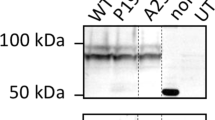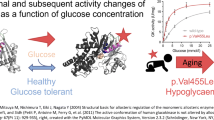Abstract
We have previously shown that heterozygous single-base deletions in the carboxyl-ester lipase (CEL) gene cause exocrine and endocrine pancreatic dysfunction in two multigenerational families. These deletions were found in the first and fourth repeats of a variable number of tandem repeats (VNTR), which has proven challenging to sequence due to high GC-content and considerable length variation. We have therefore developed a screening method consisting of a multiplex PCR followed by fragment analysis. The method detected putative disease-causing insertions and deletions in the proximal repeats of the VNTR, and determined the VNTR-length of each allele. When blindly testing 56 members of the two families with known single-base deletions in the CEL VNTR, the method correctly assessed the mutation carriers. Screening of 241 probands from suspected maturity-onset diabetes of the young (MODY) families negative for mutations in known MODY genes (95 individuals from Denmark and 146 individuals from UK) revealed no deletions in the proximal repeats of the CEL VNTR. However, we found one Danish patient with a short, novel CEL allele containing only three VNTR repeats (normal range 7–23 in healthy controls). This allele co-segregated with diabetes or impaired glucose tolerance in the patient’s family as six of seven mutation carriers were affected. We also identified individuals who had three copies of a complete CEL VNTR. In conclusion, the CEL gene is highly polymorphic, but mutations in CEL are likely to be a rare cause of monogenic diabetes.




Similar content being viewed by others
References
Bengtsson-Ellmark SH, Nilsson J, Orho-Melander M, Dahlenborg K, Groop L, Bjursell G (2004) Association between a polymorphism in the carboxyl ester lipase gene and serum cholesterol profile. Eur J Hum Genet 12:627–632
Blackberg L, Angquist KA, Hernell O (1987) Bile-salt-stimulated lipase in human milk: evidence for its synthesis in the lactating mammary gland. FEBS Lett 217:37–41
Bruneau N, Nganga A, Fisher EA, Lombardo D (1997) O-Glycosylation of C-terminal tandem-repeated sequences regulates the secretion of rat pancreatic bile salt-dependent lipase. J Biol Chem 272:27353–27361
Bruneau N, Bendayan M, Gingras D, Ghitescu L, Levy E, Lombardo D (2003a) Circulating bile salt-dependent lipase originates from the pancreas via intestinal transcytosis. Gastroenterology 124:470–480
Bruneau N, Richard S, Silvy F, Verine A, Lombardo D (2003b) Lectin-like Ox-LDL receptor is expressed in human INT-407 intestinal cells: involvement in the transcytosis of pancreatic bile salt-dependent lipase. Mol Biol Cell 14:2861–2875
Caillol N, Pasqualini E, Mas E, Valette A, Verine A, Lombardo D (1997) Pancreatic bile salt-dependent lipase activity in serum of normolipidemic patients. Lipids 32:1147–1153
de Smith AJ, Tsalenko A, Sampas N, Scheffer A, Yamada NA, Tsang P, Ben-Dor A, Yakhini Z, Ellis RJ, Bruhn L, Laderman S, Froguel P, Blakemore AI (2007) Array CGH analysis of copy number variation identifies 1284 new genes variant in healthy white males: implications for association studies of complex diseases. Hum Mol Genet 16:2783–2794
Downs D, Xu YY, Tang J, Wang CS (1994) Proline-rich domain and glycosylation are not essential for the enzymic activity of bile salt-activated lipase. Kinetic studies of T-BAL, a truncated form of the enzyme, expressed in Escherichia coli. Biochemistry 33:7979–7985
Dudbridge F (2008) Likelihood-based association analysis for nuclear families and unrelated subjects with missing genotype data. Hum Hered 66:87–98
Hansson L, Blackberg L, Edlund M, Lundberg L, Stromqvist M, Hernell O (1993) Recombinant human milk bile salt-stimulated lipase. Catalytic activity is retained in the absence of glycosylation and the unique proline-rich repeats. J Biol Chem 268:26692–26698
Higuchi S, Nakamura Y, Saito S (2002) Characterization of a VNTR polymorphism in the coding region of the CEL gene. J Hum Genet 47:213–215
Kidd JM, Cooper GM, Donahue WF, Hayden HS, Sampas N, Graves T, Hansen N, Teague B, Alkan C, Antonacci F, Haugen E, Zerr T, Yamada NA, Tsang P, Newman TL, Tuzun E, Cheng Z, Ebling HM, Tusneem N, David R, Gillett W, Phelps KA, Weaver M, Saranga D, Brand A, Tao W, Gustafson E, McKernan K, Chen L, Malig M, Smith JD, Korn JM, McCarroll SA, Altshuler DA, Peiffer DA, Dorschner M, Stamatoyannopoulos J, Schwartz D, Nickerson DA, Mullikin JC, Wilson RK, Bruhn L, Olson MV, Kaul R, Smith DR, Eichler EE (2008) Mapping and sequencing of structural variation from eight human genomes. Nature 453:56–64
Kodvawala A, Ghering AB, Davidson WS, Hui DY (2005) Carboxyl ester lipase expression in macrophages increases cholesteryl ester accumulation and promotes atherosclerosis. J Biol Chem 280:38592–38598
Li F, Hui DY (1998) Synthesis and secretion of the pancreatic-type carboxyl ester lipase by human endothelial cells. Biochem J 329(Pt 3):675–679
Lidberg U, Nilsson J, Stromberg K, Stenman G, Sahlin P, Enerback S, Bjursell G (1992) Genomic organization, sequence analysis, and chromosomal localization of the human carboxyl ester lipase (CEL) gene and a CEL-like (CELL) gene. Genomics 13:630–640
Lindquist S, Blackberg L, Hernell O (2002) Human bile salt-stimulated lipase has a high frequency of size variation due to a hypervariable region in exon 11. Eur J Biochem 269:759–767
Lombardo D (2001) Bile salt-dependent lipase: its pathophysiological implications. Biochim Biophys Acta 1533:1–28
Lombardo D, Guy O (1980) Studies on the substrate specificity of a carboxyl ester hydrolase from human pancreatic juice. II. Action on cholesterol esters and lipid-soluble vitamin esters. Biochim Biophys Acta 611:147–155
Madeyski K, Lidberg U, Bjursell G, Nilsson J (1998) Structure and organization of the human carboxyl ester lipase locus. Mamm Genome 9:334–338
McCarroll SA, Kuruvilla FG, Korn JM, Cawley S, Nemesh J, Wysoker A, Shapero MH, de Bakker PI, Maller JB, Kirby A, Elliott AL, Parkin M, Hubbell E, Webster T, Mei R, Veitch J, Collins PJ, Handsaker R, Lincoln S, Nizzari M, Blume J, Jones KW, Rava R, Daly MJ, Gabriel SB, Altshuler D (2008) Integrated detection and population-genetic analysis of SNPs and copy number variation. Nat Genet 40:1166–1174
Metzenberg AB, Wurzer G, Huisman TH, Smithies O (1991) Homology requirements for unequal crossing over in humans. Genetics 128:143–161
Raeder H, Johansson S, Holm PI, Haldorsen IS, Mas E, Sbarra V, Nermoen I, Eide SA, Grevle L, Bjorkhaug L, Sagen JV, Aksnes L, Sovik O, Lombardo D, Molven A, Njolstad PR (2006) Mutations in the CEL VNTR cause a syndrome of diabetes and pancreatic exocrine dysfunction. Nat Genet 38:54–62
Raeder H, Haldorsen IS, Ersland L, Gruner R, Taxt T, Sovik O, Molven A, Njolstad PR (2007) Pancreatic lipomatosis is a structural marker in nondiabetic children with mutations in carboxyl-ester lipase. Diabetes 56:444–449
Roudani S, Miralles F, Margotat A, Escribano MJ, Lombardo D (1995) Bile salt-dependent lipase transcripts in human fetal tissues. Biochim Biophys Acta 1264:141–150
Smith JR, Carpten JD, Brownstein MJ, Ghosh S, Magnuson VL, Gilbert DA, Trent JM, Collins FS (1995) Approach to genotyping errors caused by nontemplated nucleotide addition by Taq DNA polymerase. Genome Res 5:312–317
Stride A, Hattersley AT (2002) Different genes, different diabetes: lessons from maturity-onset diabetes of the young. Ann Med 34:207–216
Vesterhus M, Raeder H, Aurlien H, Gjesdal CG, Bredrup C, Holm PI, Molven A, Bindoff L, Berstad A, Njolstad PR (2008) Neurological features and enzyme therapy in patients with endocrine and exocrine pancreas dysfunction due to CEL mutations. Diabetes Care 31:1738–1740
Wang CS, Dashti A, Jackson KW, Yeh JC, Cummings RD, Tang J (1995) Isolation and characterization of human milk bile salt-activated lipase C-tail fragment. Biochemistry 34:10639–10644
Acknowledgments
This study was supported by funds from Helse Vest, Haukeland University Hospital, The Translational Grant Fund, University of Bergen, the Research Council of Norway (FUGE), the Danish Medical Research Council and the Danish Diabetes Association. The authors declare that the experiments comply with the current laws of Norway, Denmark and UK.
Author information
Authors and Affiliations
Corresponding author
Rights and permissions
About this article
Cite this article
Torsvik, J., Johansson, S., Johansen, A. et al. Mutations in the VNTR of the carboxyl-ester lipase gene (CEL) are a rare cause of monogenic diabetes. Hum Genet 127, 55–64 (2010). https://doi.org/10.1007/s00439-009-0740-8
Received:
Accepted:
Published:
Issue Date:
DOI: https://doi.org/10.1007/s00439-009-0740-8




